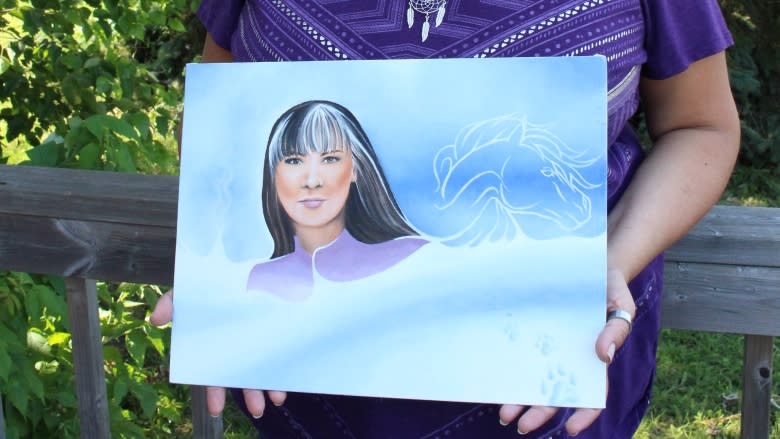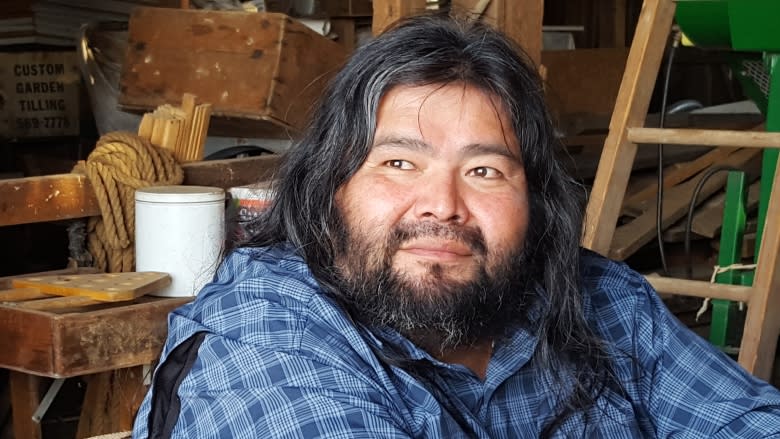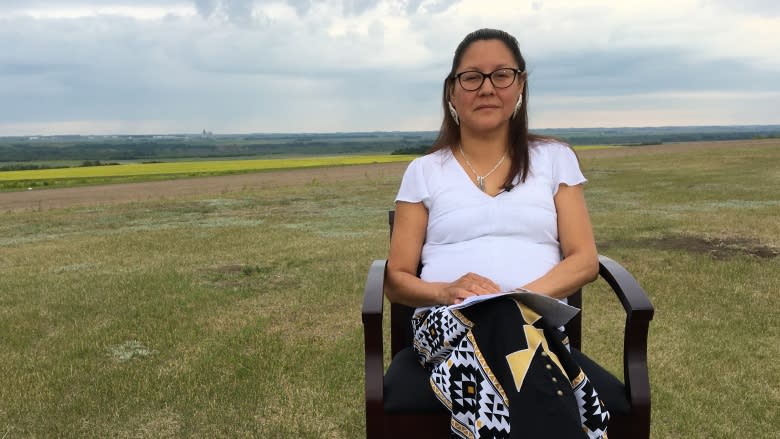Finding Cleo: CBC podcast solves decades-old mystery of Saskatchewan girl lost in Sixties Scoop
CBC News is launching Season 2 of the podcast Missing and Murdered with host Connie Walker. Listen to the first three episodes of Finding Cleo below and read about a family's search for Cleo Semaganis Nicotine, who was adopted out of her Saskatchewan First Nations community and sent to live in the U.S. 44 years ago during what became know as the Sixties Scoop.
- Subscribe to the podcast on iTunes or listen here
- Look for new episodes every Wednesday
Christine Cameron and her siblings had been searching for their sister Cleo for decades.
The last time any of them saw her was in 1974 in rural Saskatchewan when Cleo was allowed to say goodbye to one of her brothers before she was taken to her new adoptive family.
She was nine years old, and she was one of thousands of Indigenous children caught up in what is now known as the Sixties Scoop.
Cameron's brothers and sisters had heard from other relatives that Cleo had been sent to a foster family in Arkansas and had been killed while trying to hitchhike back to Little Pine First Nation, where she was originally from.
But no one had been able to say for sure whether that was true. If she was dead, Cleo's family said, they wanted to know whether her death was ever investigated and where she was buried so they could bring her body back home to Saskatchewan.
CBC News set out to help the family find out what happened to Cleo and in the course of creating the podcast Missing & Murdered: Finding Cleo uncovered the tragic truth about her fate.
- LISTEN to the first three episodes of Missing & Murdered: Finding Cleo
- Subscribe to the podcast on iTunes
"I dream of her and try something new to find her grave," Cameron said at the start of the process. "It may even be unmarked. It's such a mystery, such an impossible task to find her and bring her home — but still, I have hope."
Cameron had made a plea for help locating her oldest sister in an article she shared with CBC News.
"Cleo's spirit is very much alive. She stares at me across time, asking to come home," she wrote in the piece.
The family's search for Cleo has been marked by frustration and heartbreak.
"In a silver frame, in an oval on my piano, is a picture of my sister, very small, maybe an inch and a half tall, and that is all that remains. Cleo Semaganis Nicotine, my oldest sister."
LISTEN to Episode 1 below: The search for Cleo begins:
The Sixties Scoop
Cameron is the youngest of six children. The other siblings are Johnny, Mark, April, Annette and Cleo, also known as Cleopatra. Their last name at birth was Semaganis.
Cameron and her siblings belong to a Cree family from Saskatchewan but were made wards of the province in North Battleford, Sask., in 1972. They were all separated, except for two of the sisters, and adopted to families scattered across Canada and the United States.
LISTEN to Episode 2: Connie finds a clue in the adoption records of Cleo's sister April:
Between about 1960 and the mid-1980s, federal and provincial child welfare authorities in Canada removed thousands of Indigenous children from their biological families and communities and placed them in foster care or up for adoption, mostly in non-Indigenous families.
Some of the children were forcibly removed by police. Others were voluntarily given up.
Estimates suggest more than 20,000 children were separated from their families during the Sixties Scoop, though even the federal government says it doesn't know exactly how many.
The reasons behind the Sixties Scoop are complicated and controversial, ranging from a belief that Indigenous children would be better off — safer, healthier, with better opportunities — to a dismissal of the value of Indigenous culture, language and communities.
Many Indigenous adoptees suffered physical or sexual abuse as well as the loss of family and their sense of identity, leaving them with lasting psychological harm that has led to problems with substance abuse and violence and, in many cases, suicide.
Last October, the federal government reached an $800-million settlement with some Sixties Scoop adoptees following an Ontario Superior Court ruling in favour of survivors. That agreement in principle still has to be approved by the courts, and hearings on that are scheduled for this spring.
Looking for clues
Johnny Semaganis, the eldest Semaganis child, was the last of the siblings to see Cleo. He made her a promise that he says has haunted him ever since.
"I told her I'd find her eventually," he said. "What would you tell a nine-year-old, you know? You lie to her."
For Semaganis, who often looked after his younger brothers and sisters when they lived in Saskatchewan, the search for Cleo had been especially heartbreaking.
"Because I've found everybody else, but this is the only one I haven't found," he said.
LISTEN to Episode 3: Cleo's brother Johnny talks about the last day he saw her alive:
Semaganis and Cameron made repeated requests to the Saskatchewan government for information about Cleo but didn't get very far. They were told they had to get information from the U.S. state in which she was adopted, but they didn't know where she ended up.
"I do not know her birth date. I do not know her full name," said Cameron, who was raised in Saskatchewan in a non-Indigenous family and now has four children of her own. "I do not know her adopted name."
The National Indigenous Survivors of Child Welfare Network (NISCW), established in 2014, is one of the places people go for help finding family members or details about their own file.
Director and co-founder Elaine Kicknosway, who was adopted into a non-Indigenous family when she was four years old, said there is no standardized process for navigating what is sometimes called "repatriation" — biological relatives reuniting or discovering their home community.
The main sources of information are often the agencies that apprehended the children in the first place, whose records can be incomplete or inaccurate.
"There's no proof of how many were taken, where they sent us, no proof of how far we were sent," she said.
Kicknosway said it can be particularly challenging to get information on children who were made Crown wards and adopted outside Canada, as some of the Semaganis children were. There are reports of Indigenous children from Canada living in the United Kingdom, other parts of Europe, New Zealand and Australia. The oldest adoptees would now be in their late 60s.
The Department of Indigenous and Northern Affairs says it has no accurate data on the number of children apprehended; how many were moved out of Canada; and how many have been reunited with their families.
National database for adoptees
As the proposed Sixties Scoop settlement awaits court approval, families are still dealing with the personal fallout.
Eleanore Sunchild, a Cree lawyer who specializes in Aboriginal law and has represented Sixties Scoop adoptees, says, "a lot of times, they were so young they don't remember their family, they don't know what community they come from or even what tribe they belong to."
Sunchild says that loss of Indigenous identity coupled with separation from family is often devastating.
"The whole loss of being raised in a different home and not exactly knowing why, why they were removed — there's something wrong with them? Or was there something wrong with their family? And in a lot of instances it was just because of the policy that was in place at the time," she said.
Kicknosway says some people don't necessarily want to return to their communities.
She says they "only want to know they belong somewhere" and "have validation that they were alive" and that maybe someone missed them when they were taken away.
- LISTEN | Missing & Murdered Season 1: Who killed Alberta Williams?
Author and Sixties Scoop survivor Raven Sinclair, an associate professor of social work at the University of Regina, has written extensively on the subject. She is in the midst of a five-year study with the aim of creating a national database of adoptees.
Her goal is to create a network that can provide practical, long-term support similar to what is available to some of the people affected by the residential school system.
"An adoptee you know here in town could call up a therapist who's been approved by us ... and get some help," she said. "For some, it's been a lifetime of abuse, so it's going to take a long time for them to recover."
NISCW has set up a toll-free number to help adoptees searching for family connections and to provide peer support.
- Subscribe to the podcast on iTunes
- Look for new episodes every Wednesday




